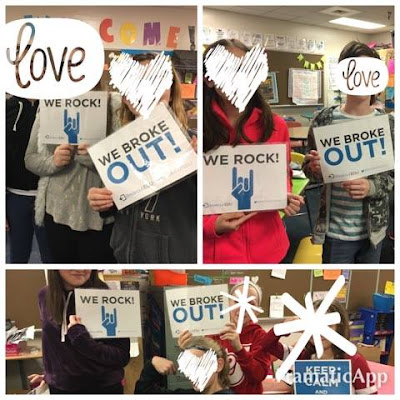Then, I found a digital Breakout about plot structures. (Actually, it might have been one of my teammates who found the digital breakout, but I'm not really sure. My team and I spend a lot of time together - A LOT - to the point I'm not sure who had the original idea. So, teammates, if you shared it, thanks for it and the blogpost idea! Love you!) So anyway, I thought it might be a good review before our end-of-quarter assessment. It ended up being a GREAT review! The kids were extremely engaged and had the opportunity to review concepts. It was a great alternative to our other review games. And before long, kids started asking if we could do Breakouts at other times. Yes, you read that correctly - kids WANTED to work on content related material. It was nothing short of a miracle.
 |
| Look at them working together! They were so engaged. |
Digital Breakouts are available in several places, as more teachers are becoming comfortable with making them. We've purchased a couple from TeachersPayTeachers gathered some from our favorite blogs, and you can purchase a subscription to Breakout EDU for an unbelievable amount of games for only $60 for the year. (Get creative about getting this financed for you instead of spending that money from you own pocket. For example, I wrote a grant to our education foundation, and they bought us a subscription for next school year.) But the place we check first is always the Breakout EDU Digital Sandbox. These FREE game are organized so that you can search by subject, content, or grade level which makes it very user-friendly.
Breakouts are great, but just like anything else in our classrooms, success comes not from the resource, but the implementation. Here are my tips:
1) Start with a lesson on cursors. As weird as this sounds, trust me. Learn from my mistake. I didn't this year, and the first couple of games we were rough kids didn't see how to some pictures and texts are hyperlinked to take you to a clue. I know next year,I actually want to start with a mini-lesson on the different cursor types because that's really important in reading online texts and Breakouts. The cursor will alert you to whether or not something can be highlighted, clicked on, typed in, etc. Digital readers have to recognize this and what other way can I make that mini-lesson engaging than creating a fun, immediate need for that information? Digital Breakout for the win! (This lesson from Smekens Education would be a perfect place to start.)
2) Start with a fun, easy Breakout. I don't start with a content one because I don't want kids to miss out on learning or reviewing specific content as they are trying to master using Breakouts. The Disney ones in the Sandbox are perfect for teaching how to use the different features of a digital Breakout.
3) Build persistence with consistence. My advanced kids are used to things being easy for them most of the time. They have never really struggled with school, so trying something over and over has never really been required of them until they did their first Breakout. The first Breakout game we did, my kids started complaining around the 7-10 minute mark that this was too hard. The second time, it was around the 15 minute mark, so I actually gave them $5 Raider Bucks (our school money) because they had beat their time. The third game it was round the 20-22 minute mark, so I rewarded them again. This last time we played, I gave them a super challenging one, and they still didn't say anything about it being too hard! I was super impressed so everyone earned $15 Raider Bucks! By doing about one Breakout a month, the kids are finally getting used to the challenge...and they enjoy it!
 |
| Their end-of-game poses are alway fun! I laminated the signs so we use them for every game. |
5) Reward effort, not time. The first time we played I made the mistake of only rewarding the first
group. Guess what happened? After the first group won, no other group wanted to finish so they lost out on valuable learning opportunities. Now I reward every group that finishes. We make a big deal of "breaking out" by taking their pictures with the signs and everyone earning $25-50 Raider Bucks. (Print end-of-game signs from here.)
That's how we do it. Once you do one digital Breakout, it actually gets much easier. Let me know if you use Breakouts in your classroom and what you think. Also, the links to your favorite digital Breakouts in the comments.


